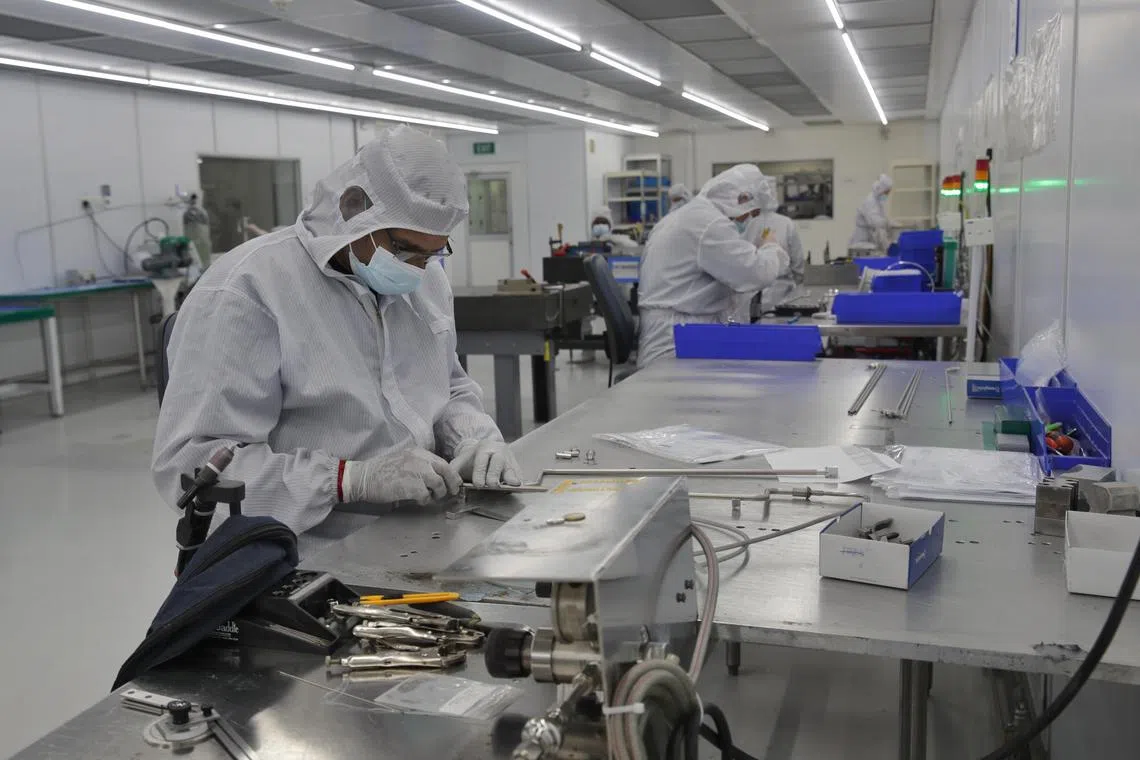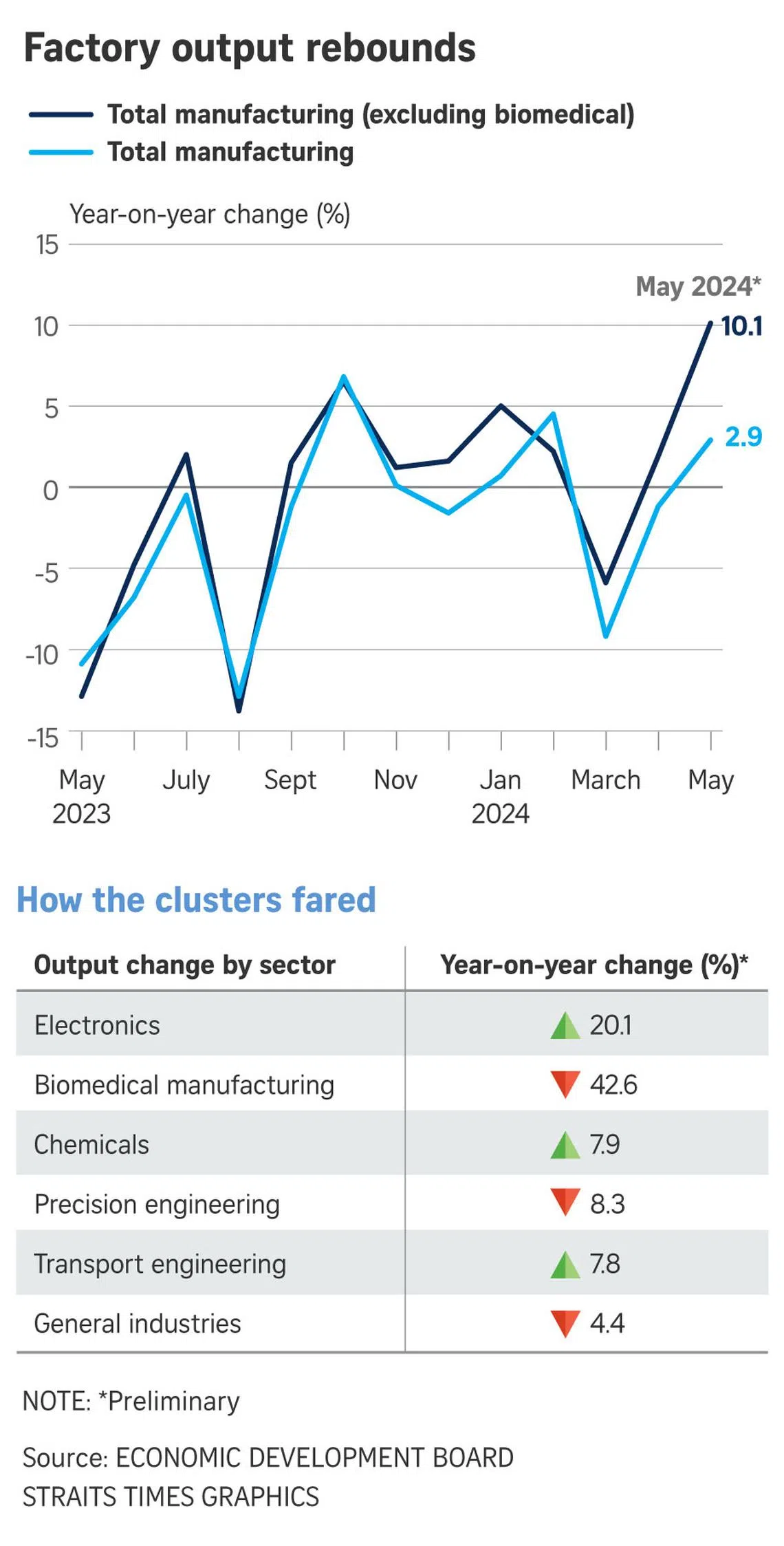Singapore factory output beats forecasts with 2.9% rise in May on electronics rebound
Sign up now: Get ST's newsletters delivered to your inbox

Semiconductors, which make up about 41 per cent of total factory output, surged 20.6 per cent in Singapore.
PHOTO: ST FILE
Follow topic:
SINGAPORE – Singapore’s manufacturing output turned positive in May, fuelled by a rebound in the key electronics sector.
Total output grew a better-than-expected 2.9 per cent year on year in May, after a revised 1.2 per cent drop in April and the 9.2 per cent contraction suffered in March.
Economists in a Bloomberg poll had predicted a 1.4 per cent expansion.
Excluding the more volatile biomedical industry, production rose 10.1 per cent, data released by the Economic Development Board on June 26 showed.
On a seasonally adjusted month-on-month basis, production increased by 1.1 per cent in May. Excluding biomedical manufacturing, it rose 7.7 per cent.
The electronics industry, which accounts for nearly half of Singapore’s manufacturing production, saw output grow by 20.1 per cent year on year, after shrinking 1.1 per cent in April.
Within electronics, semiconductors – which make up about 41 per cent of total factory output – surged 20.6 per cent.
Other electronics modules and components segments rose 30.2 per cent on the back of improved orders, while computer peripherals and data storage grew 24.9 per cent, and infocomms and consumer electronics production added 7 per cent.
DBS Bank economist Chua Han Teng said the electronics cluster’s performance will be instrumental to Singapore’s factory recovery in 2024.
He noted: “Electronics production started to catch up in May, after being weak in the first four months of 2024, and it will be key to watch for sustained positive momentum amid the ongoing global tech cycle upturn.
“The global tech cycle will likely be underpinned by the replacement of smartphones and personal computers, as well as the broadening use of artificial intelligence applications.”
The biomedical manufacturing industry was the worst performer in May, with production plunging 42.6 per cent year on year.
Within the cluster, the output of the medical technology segment increased 7.8 per cent on account of higher exports of medical devices. But the pharmaceuticals segment contracted 67.2 per cent because of a different mix of active pharmaceutical ingredients being produced compared with a year ago.
Output in the transport engineering sector grew 7.8 per cent in May, over the same month in 2023.
The marine and offshore engineering segment led the charge with an expansion of 16 per cent, due to a higher level of activity in the shipyards as well as increased production in oil and gas field equipment.

The aerospace segment grew 6.9 per cent as a result of higher demand for aircraft parts and more maintenance, repair and overhaul jobs from commercial airlines.
In the precision engineering industry, output fell 8.3 per cent year on year with all segments recording production declines.
The machinery and systems segment contracted 5.6 per cent, led by lower production of back-end semiconductor equipment and process control equipment.
The precision modules and components segment declined 10.5 per cent, due to lower output in optical instruments and dies, moulds, tools, jigs and fixtures.
General manufacturing output fell 4.4 per cent over May 2023, weighed down by lower production in the printing and miscellaneous industries segments, with the latter recording lower production of construction-related materials.
But the food, beverages and tobacco segment crept up 0.3 per cent as higher production of beverage concentrates and cocoa products was partially offset by lower production of animal feeds and additives.
The chemicals cluster was in the black, with output rising 7.9 per cent year on year. This was largely led by the petroleum and petrochemicals segments, which grew 29.4 per cent and 4.4 per cent respectively, on the back of a low production base last year due to plant maintenance shutdowns.
The other chemicals segment declined 4.6 per cent with lower output of fragrances.
OCBC Bank chief economist Selena Ling said that the global economy is on track for a soft landing.
“Global growth footing is solid... This will benefit Singapore’s manufacturing sector, but the fear is that US-China tensions may step again ahead of the US elections,” she said.
Maybank economist Brian Lee noted that the increase in output suggests that Singapore’s second-quarter GDP growth could strengthen to around 3 per cent.
“Apart from manufacturing, the economy will be supported by robust outturns in trade-related services, on the back of the recent surge in container and air cargo traffic,” he said.
“The finance sector is also expected to pick up, on the back of a rebound in loan demand and robust market transactions,” Mr Lee added.


